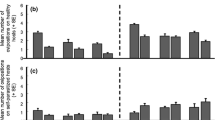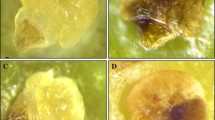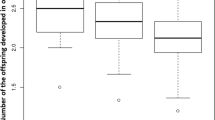Abstract
Host rejection, superparasitism, and ovicide are three possible host selection strategies that parasitoid females can adopt when they encounter parasitized hosts. These differ in costs (in terms of time and energy required) and benefits (in terms of number and quality of offspring produced). Their relative payoff should vary with patch quality, (i.e., proportion of parasitized hosts present), and female choice between them should be adapted accordingly. We conducted behavioral observations to test the effect of the ratio of parasitized/unparasitized hosts present in a patch on the host selection strategies of Pachycrepoideus vindemmiae Rondani (Hymenoptera: Pteromalidae). This species being a generalist known to attack hosts of a great range of size, we also tested the impact of host size on female decisions with two host species differing greatly in size (Drosophila melanogaster and Delia radicum). We evaluated the adaptive value of each strategy in relation to host parasitization status and host size by measuring their duration and the potential number of offspring produced.
Similar content being viewed by others
REFERENCES
Antolin, M. F., Ode, P. J., and Strand, M. R. (1995). Variable sex ratios and ovicide in an outbreeding parasitic wasp. Anim. Behav. 49: 589-600.
Arakawa, R. (1987). Attack on the parasitized host by a primary solitary parasitoid, Encarsia formosa (Hymenoptera: Aphelinidae): The second female pierces, with her ovipositor, the egg laid by the first one. Appl. Entomol. Zool. 22: 644-645.
Crandell, H. A. (1939). The biology of Pachycrepoideus dubius Ashmead (Hymenoptera), a pteromalid parasite of Piophila casei Linne. Ann. Entomol. Soc. 32: 632-654.
David, J. (1962). A new medium for rearing Drosophila in anexic conditions. Drosophila Info. Serv. 93: 18
Fitt, G. (1990). Comparative fecundity, clutch size, ovariole number and egg size of Dacus tryoni and D. jarvisi, and their relationship to body size. Entomol. Exp. Appl. 55: 11-21.
Goertzen, R., and Doutt, R. L. (1975). The ovicidal propensity of Goniozus. Ann. Entomol. Soc. 68: 869-870.
Goubault, M., Plantegenest, M., Poinsot, D., and Cortesero, A. M. (2003). Effect of expected offspring survival probability on host selection in a solitary parasitoid. Entomol. Exp. Appl. 109: 123-131.
Goubault, M., Krespi, L., Boivin, G., Poinsot, D., Nénon, J.-P., and Cortesero, A. M. (2004). Intraspecific variations in host discrimination behavior in the pupal parasitoid Pachycrepoideus vindemmiae Rondani (Hymenoptera: Pteromalidae). Env. Entomol. (in press).
Grandgirard, J., Poinsot, D., Krespi, L., Nénon, J.-P. and Cortesero, A. M. (2002). Costs of secondary parasitism in the faculative hyperparasitoid Pachycrepoideus dubius: Does host size matter? Entomol. Exp. Appl. 103: 239-248.
Hardy, I. C. W., and Blackburn, T. M. (1991). Brood guarding in a bethylid wasp. Ecol. Entomol. 16: 55-62.
King, B. H. (1994). How do female parasitoid wasps assess host size during sex-ratio manipulation? Anim. Behav. 48: 511-518.
Mackauer, M. (1991). Host discrimination and larval competition in solitary endoparasitoids. in Mackauer, M., Ehler, L. E., and Roland, J. (eds.), Critical Issues in Biological Control, Intercept, Anover, pp. 41-62.
Mayhew, P. J. (1997). Fitness consequences of ovicide in a parasitoid wasp. Entomol. Exp. Appl. 84: 115-126.
Mayhew, P. J. (1998). Offspring size-number strategy in the bethylid parasitoid Laelius pedatus. Behav. Ecol. 9: 54-59.
McGinley, M. A., and Charnov, E. L. (1988). Multiple resources and the optomal balance between size and number of offspring. Evol. Ecol. 2: 77-84.
Nell, H. W., and van Lenteren, J. C. (1982). Gastheerdiscriminatie bij Pachycrepoideus vindemiae: een voorbeeld van bezettingstype-concurrentie bij sluipwespen. Vakbl. Biol. 1: 2-6.
Netting, J. F., and Hunter, M. S. (2000). Ovicide in the whitefly parasitoid, Encarsia formosa. Anim. Behav. 60: 217-226.
Neveu, N., Kacem, N., and Nénon, J. P. (1996). A method for rearing Trybliographa rapae W. on Delia radicum L. OILB/SROP Bull. 19: 173-178.
Noldus, L. P. J. J. (1991). The Observer: A software for collection and analysis of observational data. Behav. Res. Meth. Instrum. Comp. 23: 415-429.
Nostvik, E. (1954). Biological studies of Pachycrepoideus dubius Ashmead (Chalcidoidae: Pteromalidae), a pupal parasite of various Diptera. Oikos. 5: 195-204.
Petersen, G., and Hardy, I. C. W. (1996). The importance of being larger: Parasitoid intruder-owner contests and their implications for clutch size. Anim. Behav. 51: 1363-1373.
Price, P. W. (1970). Biology of and host exploitation by Pleolophus indistinctus (Hypmenoptera: Ichneuminidae). Ann. Entomol. Soc. 63: 1502-1509.
Roitberg, B. D., Boivin, G., and Vet, L. E. M. (2001). Fitness, parasitoids, and biological control: An opinion. Can. Entomol. 133: 429-438.
Rueda, L. M., and Axtell, R. C. (1985). Guide to common species of pupal parasites (Hymenoptera: Pteromalidae) of house fly and other Muscoid flies associated with poultry and livestock manure. Tech. Bull. 278: 2
Schmidt, J. M., and Smith, J. J. B. (1987). Short interval time measurement by a parasitoid wasp. Science 237: 903-905.
Sirot, E., Ploye, H., and Bernstein, C. (1997). State dependent superparasitism in a solitary parasitoid: Egg load and survival. Behav. Ecol. 8: 226-232.
Smith, C. C., and Fretwell, S. D. (1974). The optimal balance between the size and number of offspring. Am. Nat. 108: 499-506.
Smith, R. H., and Lessels, C. M. (1985). Oviposition, ovicide and larval competition in granivorous insects. in Sibly, R. M., and Smith, R. H. (eds.), Behavioural Ecology, Blackwell Scientific, Oxford, pp. 423-448.
Strand, M. R., and Godfray, H. C. J. (1989). Superparasitism and ovicide in parasitic Hymenoptera: Theory and a case study of the ectoparasitoid Bracon hebetor. Behav. Ecol. Sociobiol. 24: 421-432.
van Alebeek, F. A. N., Rojas-Rousse, D., and Leveque, L. (1993). Interspecific competition between Eupelmus vuilleti and Dinarmus basalis, two solitary ectoparasitoids of Bruchidae larvae and pupae. Entomol. Exp. Appl. 69: 21-31.
van Alphen, J. J. M., and Thunissen, I. (1983). Host selection and sex allocation by Pachycrepoideus vindemiae Rondani (Pteromalidae) as a facultative hyperparasitoid of Asobara tabida Nees (Braconidae; Alysiinae) and Leptopilina heterotoma (Cynipoidea; Eucoilidae). Neth. J. Zool. 33: 497-514.
van Alphen, J. J. M., and Visser, M. E. (1990). Superparasitism as an adaptive strategy for insect parasitoids. Annu. Rev. Entomol. 35: 59-79.
van Lenteren, J. C. (1981). Host discrimination by parasitoids. in Nordlund, D. A., Jones, R. L., and Lewis, W. J. (eds.). Semiochemicals, Their Role in Pest Control, John Wiley, New York, pp. 153-180.
Visser, M. E., van Alphen, J. J. M., and Nell, H. W. (1992). Adaptive superparasitism and patch time allocation in solitary parasitoids: The influence of pre-patch experience. Behav. Ecol. Sociobiol. 31: 163-171.
Winkler, D. W., and Wallin, K. (1987) Offspring size and number: a life history model linking effort per offspring and total effort. Am. Nat. 129: 708-720.
Author information
Authors and Affiliations
Corresponding author
Rights and permissions
About this article
Cite this article
Goubault, M., Fourrier, J., Krespi, L. et al. Selection Strategies of Parasitized Hosts in a Generalist Parasitoid Depend on Patch Quality but Also on Host Size. Journal of Insect Behavior 17, 99–113 (2004). https://doi.org/10.1023/B:JOIR.0000025135.94296.8d
Issue Date:
DOI: https://doi.org/10.1023/B:JOIR.0000025135.94296.8d




